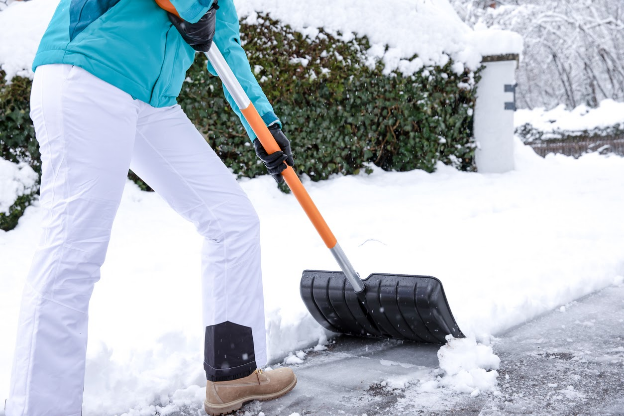Choose Appropriate Clothing
You may already know the importance of dressing in layers and wearing a hat, but it's also important to think about the materials you wear. Water-resistant or waterproof outwear will help keep you dry in case of snow or rain, while wool or fleece materials will help keep you warm. If you’re doing a winter sport like skiing, snowboarding or snowshoeing, use wool or synthetic base layers—cotton layers may be comfortable, but they trap moisture and take too long to dry for them to be a safe option if you sweat.Think about the type of footwear you're wearing too. Thick soles will help insulate your feet from the cold ground, and if you have to walk in snow or ice, make sure to invest in a good pair of boots with traction.
Proper Snow Shoveling Technique
Shoveling snow may be one of the least popular winter activities, but that doesn't mean you should rush through it. Practicing proper technique is essential for avoiding injury. According to a 17-year study from The American Journal of Emergency Medicine, 11,000 people are hospitalized every year due to snow shoveling-related accidents. The most common reasons for injury include slipping and overexertion. Therefore, it's important to make sure you take your time and move intentionally.- Choose a good shovel: A shovel that's too small will require you to bend over more, increasing your chances of a back injury. Conversely, a too-large shovel will be harder to control and could easily cause you to trip.
- Push the snow instead of lifting it: Lifting snow puts unnecessary strain on your back and can lead to slipped discs or other back injuries. Instead, do your best to push the snow away.
- Avoid twisting motions: Twisting while shoveling can lead to injury, so be sure to avoid this motion whenever possible. Rather than twisting at your spine, use your legs to turn your entire body in the desired direction.
- Do not toss snow over your shoulder: Tossing snow over your shoulder involves lifting it and twisting your body, two things you should avoid. Instead, shovel straight and avoid pushing the snow long distances.
Exercising in the Winter
At The Steadman Clinic, we're in the business of keeping people active—even in the winter. Though the cold weather may make you choose the gym over exercising outside, there are still some things you should keep in mind.Dress in layers: As mentioned above, dressing in layers is important during the winter months. Start with a thin layer of moisture-wicking fabric to draw sweat away from your body, then add a layer of insulation followed by an outer shell to keep you dry and warm.
Warming up: It may take longer to warm up before your workout in the winter than in the warmer months. This is especially true for those who exercise outside. Start your workout with a few bodyweight exercises, then progress to more strenuous activities once you're warm and ready.
Protecting your face: Protecting the skin on your face from cold weather or snow is extremely important—exposure can be dangerous during certain conditions. First, always apply sunscreen before going outside in the winter, even if it's cloudy. Second, consider wearing glasses or goggles to protect your eyes from snow and wind. A buff around the neck is a great accessory to pull up over the lower face to protect from the cold, especially when skiing, running, or moving at a brisk pace. Look for moisture-wicking materials that are also breathable.
Use proper footwear: Just like with shoveling, it's important to use the right type of footwear when exercising in cold weather. Snow boots or water-resistant shoes will keep your feet warm and dry, while traction cleats can help you stay safe on icy surfaces.
In addition to following these tips, make sure to listen to your body and take breaks as needed. If you're feeling too cold, it's probably time to head inside.


